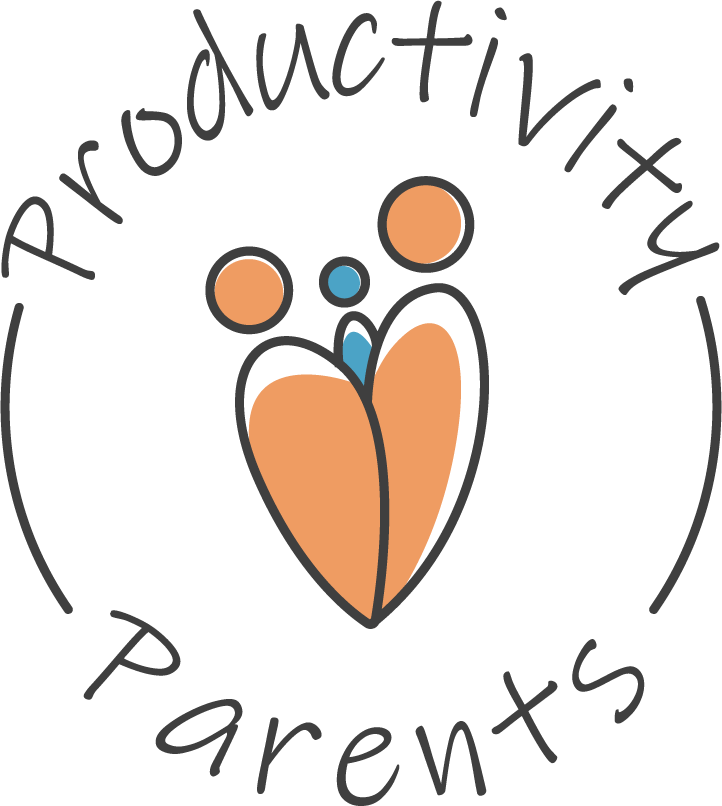Parenting in today’s hyper-connected world brings unique challenges that can intensify stress levels. Between juggling work responsibilities, household tasks, and children’s needs, many parents find themselves overwhelmed. Modern technology, when used intentionally, can provide effective tools for managing parental stress while creating a healthier home environment for the entire family.
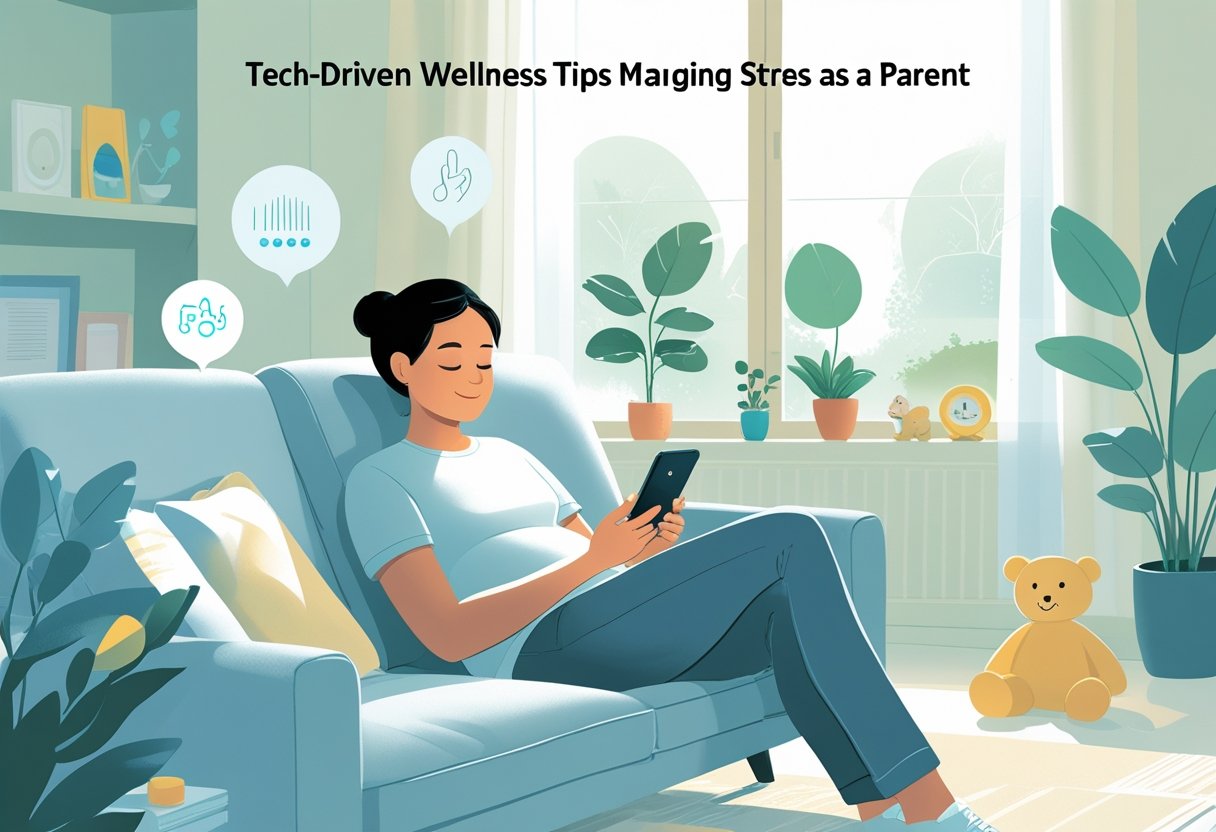
I’ve discovered that incorporating digital wellness solutions into daily routines can transform how we handle parenting pressures. From breathing exercises that take just two to three minutes to balanced screen time approaches that foster creativity, technology offers accessible ways to maintain calm amid chaos. Creating a well-structured home environment through tech tools can support not only our mental health but our children’s development too.
Key Takeaways
- Mindfulness apps and wearable stress monitors provide real-time support for parents to recognize and manage overwhelming moments.
- Creating tech-enhanced relaxing spaces at home and establishing clear digital boundaries improves family well-being and reduces stress.
- Online communities and virtual support networks offer valuable connection points for parents seeking advice and emotional support without leaving home.
Understanding Parental Stress in the Digital Age

Parental stress has evolved significantly with technological advancement. Modern parents face unique pressures as they navigate raising children in an environment saturated with screens, social media, and constant connectivity.
Common Causes and Triggers of Modern Stress
Today’s parents experience stress from multiple sources that didn’t exist for previous generations. The complexity of managing social media creates constant pressure to monitor children’s online activities and protect them from harmful content.
I’ve observed that decision fatigue becomes overwhelming when parents must evaluate countless digital tools, apps, and platforms for appropriateness. This creates a never-ending cycle of research and vigilance.
Financial strains also contribute significantly as parents feel pressured to provide the latest devices and technologies to keep children competitive. The fear of children falling behind academically or socially without access to certain technologies creates additional anxiety.
Work-life boundaries have blurred considerably with remote work and 24/7 connectivity, making it difficult for parents to be fully present with their children or truly disconnect from professional responsibilities.
Recognizing the Signs of Parental Burnout
Physical symptoms often appear first when parents experience digital-age burnout. These include:
- Persistent fatigue regardless of sleep
- Headaches and muscle tension
- Disrupted sleep patterns
- Digestive issues
Emotional indicators become increasingly apparent as burnout progresses. I’ve found that parents experiencing burnout often feel detached from their children or find less joy in parenting activities they previously enjoyed.
Cognitive signs include difficulty focusing, forgetfulness, and decreased problem-solving abilities. Many parents describe feeling mentally foggy or unable to process new information effectively.
Behavioral changes such as increased irritability, withdrawal from social connections, or relying heavily on screens for childcare can signal problematic stress levels requiring intervention.
Impact of Technology on Parental Well-Being
Technology creates a double-edged sword for parental well-being. On one hand, digital tools offer unprecedented convenience through parenting apps, online support communities, and resource accessibility. This can reduce certain stressors related to information gathering and community building.
However, technology also creates new pressures. Research on parenting stress shows that self-tracking tools and constant comparison with idealized parenting standards online can increase anxiety and feelings of inadequacy.
The “always on” expectation means parents rarely experience true downtime. I’ve noted that even during family activities, many parents remain tethered to work through smartphones, preventing full mental restoration.
Digital communication has also transformed family dynamics, sometimes reducing meaningful face-to-face interactions. Creating screen-free times and spaces becomes crucial for maintaining family connections and reducing technology-induced stress.
Leveraging Mindfulness Apps for Daily Calm

Digital tools have revolutionized how parents manage stress through accessible mindfulness practices. I’ve found several effective applications that offer quick mental breaks and structured meditation sessions designed to fit into a parent’s hectic schedule.
Guided Meditation Tools for Busy Parents
Calm stands out as a leading mental health app that offers guided meditations specifically designed for people with limited time. I appreciate that it provides sessions ranging from just 2 minutes to longer 30-minute practices, making it possible to fit mindfulness into even the busiest parenting schedule.
Many apps offer specialized content for different parental challenges:
- Morning routines to start the day centered
- Quick stress relief sessions for those moments between childcare tasks
- Evening wind-downs to improve sleep quality
What makes these tools particularly valuable is their accessibility—I can practice mindfulness while waiting at school pickup or after the kids go to bed. The audio-guided format requires minimal setup, allowing me to close my eyes and focus immediately.
Features of Effective Mindfulness Applications
The most useful mindfulness apps offer variety and personalization options. I look for apps with:
Essential Features:
- Customizable session lengths
- Progress tracking
- Reminder notifications
- Offline accessibility
Research-based tools are particularly important when selecting an app. I’ve noticed better results with programs developed by mental health professionals rather than general wellness platforms.
Some apps include kid-centered content, which allows me to practice mindfulness alongside my children. This dual-purpose feature helps model healthy coping strategies while addressing my own stress.
Many platforms now incorporate sleep stories and relaxation techniques that extend beyond traditional meditation, creating a comprehensive approach to mental wellbeing that addresses multiple stress triggers simultaneously.
Integrating App-Based Practices Into Family Routines
I’ve successfully incorporated mindfulness apps into our family schedule by creating dedicated “calm zones” in our home. Setting aside just 5-10 minutes after breakfast for a quick family meditation has improved our collective mood.
Evening routines benefit particularly from these digital tools. Instead of scrolling through social media, I use meditation and relaxation apps to help transition from parent mode to personal time. This boundary-setting practice has significantly reduced my nighttime stress.
For consistency, I recommend:
- Starting with short, achievable sessions
- Using the same app features at consistent times
- Creating environmental cues (like dimming lights)
- Celebrating small victories in practice consistency
While technology is often viewed as a stress inducer, these purposeful applications transform our devices into tools for mental wellbeing rather than distraction.
Wearable Technology for Stress Monitoring
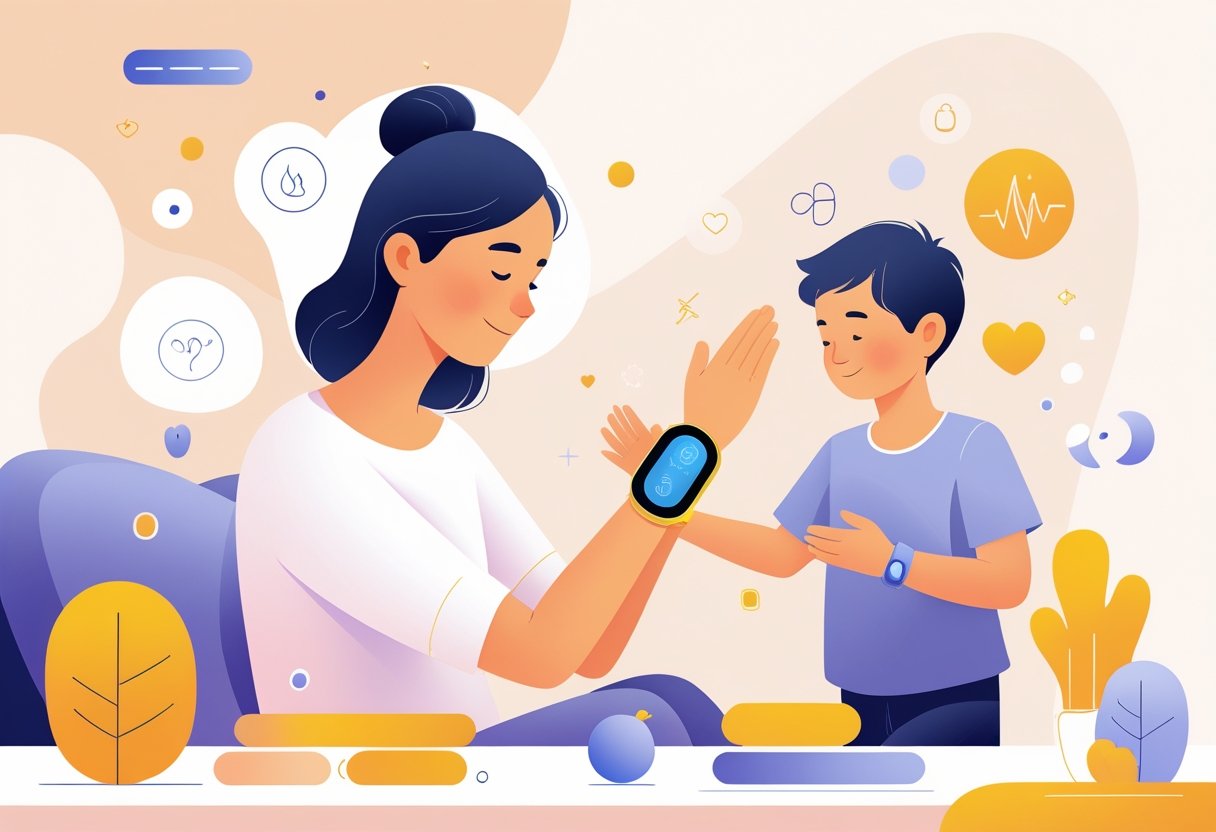
Modern wearable devices have revolutionized how parents can monitor and manage their stress levels. These smart technologies provide valuable insights by tracking physiological indicators that correlate with stress, helping busy parents take proactive steps toward better wellbeing.
Tracking Heart Rate Variability and Sleep Quality
Heart rate variability (HRV) is one of the most reliable biomarkers for stress assessment that modern wearables can track. Lower HRV typically indicates higher stress levels, while higher variability suggests better resilience and recovery. Most smartwatches and fitness bands now include this feature, making it accessible for everyday use.
Sleep quality tracking is another essential function that helps me understand my stress patterns. Poor sleep and high stress create a difficult cycle that many parents experience. My wearable device monitors:
- Sleep duration
- Sleep stages (light, deep, REM)
- Sleep disruptions
- Nighttime heart rate
When I review this data alongside my daily activities, I can identify which days or events trigger stress responses in my body. This awareness allows me to make adjustments to my schedule or implement stress-reduction techniques when needed.
Real-Time Stress Alerts and Notifications
The true power of wearable stress monitoring comes from real-time feedback. Modern devices can detect sudden changes in heart rate, breathing patterns, or skin conductance that might indicate rising stress levels.
When my watch detects these changes, it sends gentle reminders to take a deep breath or step away for a moment. This immediate intervention often prevents stress from escalating further. Some advanced wearables even offer guided breathing exercises that automatically activate when stress signals are detected.
I’ve found these timely nudges particularly helpful during chaotic parenting moments. When juggling multiple responsibilities, it’s easy to miss my own stress signals until they’ve already affected my mood and interactions with my children.
Data Analysis for Personalized Wellness Strategies
The long-term value of wearable stress monitoring lies in data analysis and pattern recognition. After weeks of consistent use, these devices can reveal surprising insights about my personal stress triggers.
My wearable app shows clear correlations between:
- Time periods with highest stress (morning rush vs. evening routines)
- Environmental factors affecting my stress levels
- Activities that consistently reduce my stress
- Recovery time needed after stressful events
Wearable devices allow quantification of stress levels over time, creating an objective measurement system rather than relying solely on subjective feelings. I use this data to create targeted wellness strategies that address my specific needs as a parent.
For example, after noticing consistently elevated stress during morning routines, I implemented a 10-minute meditation practice before my children wake up. My wearable data confirmed this simple change reduced my morning stress readings by nearly 30%.
Smart Home Solutions for Creating Relaxing Spaces
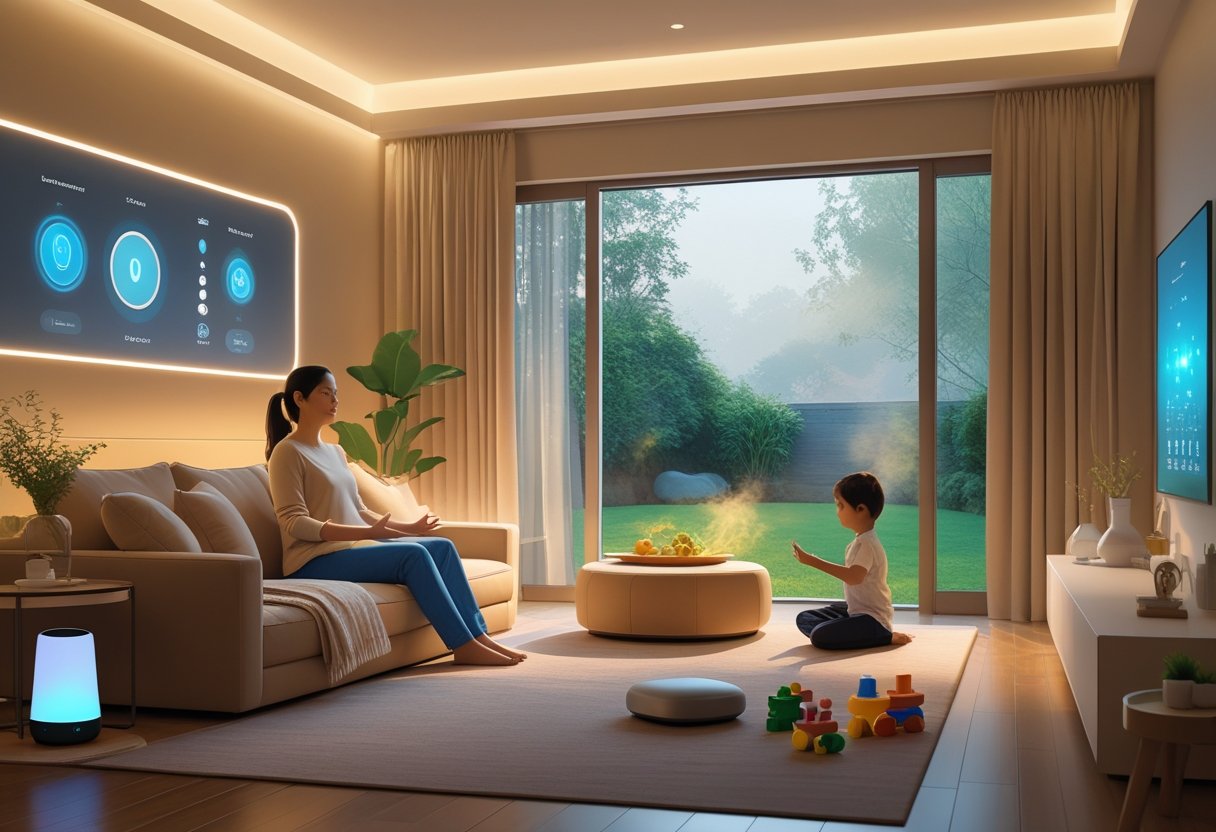
Modern technology offers powerful tools to transform your living environment into a calming sanctuary. Smart home devices can automate stressful tasks and create ambiance that promotes relaxation after hectic parenting days.
Using Smart Lighting for Mood Enhancement
Smart lighting systems provide an effective way to influence your home’s atmosphere. I’ve found that color-changing bulbs can be programmed to shift from energizing bright white during productive hours to warmer, softer tones in the evening when it’s time to wind down.
Many systems allow you to create preset “scenes” activated by a single tap on your phone. For example, a “relaxation mode” might dim lights to 30% brightness with a gentle amber glow throughout your living space.
Smart home technology can play a pivotal role in reducing anxiety and enhancing comfort. Motion sensors can be particularly useful for parents, automatically illuminating pathways for late-night child check-ins without harsh overhead lighting that disrupts sleep patterns.
Consider these popular smart lighting options:
- Philips Hue: Extensive ecosystem with many fixture types
- LIFX: No hub required, connects directly to WiFi
- Nanoleaf: Decorative panels that double as ambient lighting
Voice Assistants for Family Organization
Voice assistants streamline household management by centralizing information and automating routine tasks. I can ask my assistant to add items to shopping lists, set reminders for school events, or quickly check calendar appointments without stopping what I’m doing.
For busy parents, smart home technology helps schedules run smoother and removes routine stressors. Setting up family routines is particularly valuable – a single command like “good morning” can trigger multiple actions such as reading the weather forecast, starting the coffee maker, and playing gentle wake-up music.
Voice assistants can also manage other smart devices, creating a cohesive system. “Movie night” commands can dim lights, lower smart blinds, and turn on the TV to your streaming service of choice.
Most assistants offer parental controls to limit certain functions and content for children’s accounts, ensuring age-appropriate interactions while maintaining the organizational benefits for the whole family.
Virtual Support Networks and Online Communities
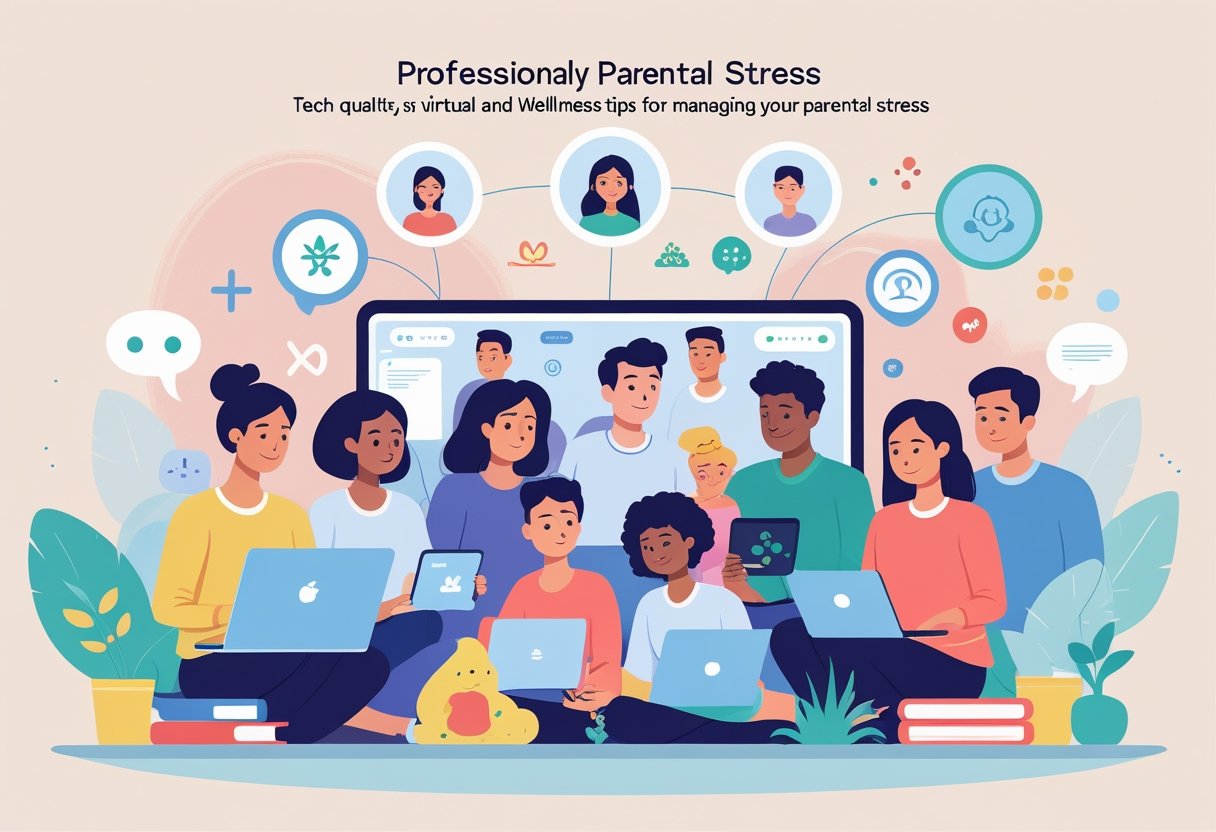
Technology has created powerful opportunities for parents to find support, understanding, and professional guidance without leaving home. Digital connections can significantly reduce feelings of isolation and provide valuable resources during challenging parenting moments.
Connecting with Other Parents Digitally
Online peer communities offer a safe haven where parents can share experiences, seek advice, and find emotional support. I’ve found that specialized parenting forums, Facebook groups, and apps like Peanut connect parents with similar challenges or children of the same age.
Research suggests that members of these communities report greater belonging while experiencing reduced anxiety and stress. This has certainly been true in my experience.
When selecting online communities, I recommend:
- Groups with active moderation
- Communities that maintain respectful discourse
- Spaces that align with your parenting philosophy
- Private or closed groups for more sensitive discussions
Remember to maintain privacy boundaries and avoid sharing identifying information about your children.
Accessing Professional Guidance via Telehealth
Telehealth services have transformed how parents access mental health support and parenting guidance. I can now connect with therapists, counselors, and parenting coaches from my living room.
Many insurance plans cover telehealth services, making professional support more accessible than ever. Apps like BetterHelp, Talkspace, and specialized parenting support platforms offer flexible scheduling that works around busy family routines.
Technology has revolutionized mental health resource accessibility, providing support at your fingertips. Video sessions, messaging options, and even AI-assisted coaching tools offer different levels of engagement.
I’ve found that even brief 15-minute check-ins with professionals can provide crucial coping strategies during stressful parenting periods.
Managing Screen Time and Digital Boundaries
As parents juggling technology demands, establishing clear digital boundaries is essential for family wellness and stress reduction. Setting limits on screen time and using helpful tools can create a healthier relationship with technology for the whole family.
Establishing Healthy Technology Use Habits
I’ve found that setting clear screen time limits is fundamental to managing digital overwhelm. I recommend creating a family tech agreement that explicitly outlines when and where screens are acceptable.
Screen-free zones and times should be non-negotiable. For example:
- No devices during meals
- No screens in bedrooms
- Screen blackout period 1-2 hours before bedtime
I’ve noticed how effective it is to model healthy digital habits myself. Children observe and mimic parental behavior, so I put my phone away during family time.
Encouraging alternative activities helps reduce screen dependency. I keep board games, art supplies, and outdoor equipment easily accessible to make screen-free time appealing.
Parental Control Apps for Family Balance
I’ve tested several digital tools that help maintain technology boundaries without constant monitoring. Parental control solutions provide automated support for the limits we set as parents.
Quality apps offer features like:
- Time limits: Automatically enforce daily screen allowances
- Content filtering: Block inappropriate websites and apps
- Usage reports: Track time spent on different activities
- Remote management: Adjust settings from my own device
I find these tools particularly helpful during busy workdays when I can’t directly supervise. The best approach is using these apps as supplements to ongoing conversations about digital well-being, not as replacements for parental guidance.
When implementing these tools, I make sure to explain the reasons behind limits rather than simply imposing restrictions. This builds digital literacy and self-regulation skills.
Self-Care Through Digital Wellness Platforms
Digital wellness tools offer parents practical ways to manage stress through accessible technology. These platforms provide structure for fitness routines and valuable educational resources that fit into busy parenting schedules.
Personalized Fitness Programs and Tracking
I’ve found that fitness apps can transform how parents incorporate exercise into their hectic schedules. Many platforms now offer quick 10-20 minute workouts specifically designed for busy parents who need to exercise at home while watching children.
Activity trackers help me quantify my progress and maintain motivation. When I track my daily steps or exercise minutes, I’m more likely to prioritize movement throughout my day. This model of self-tracking provides concrete data to help understand how physical activity impacts my stress levels.
Several apps offer meditation and breathing exercises that can be completed in as little as 2-5 minutes. These micro-practices fit perfectly between parenting responsibilities and provide immediate stress relief.
Resource Libraries for Stress Education
Digital wellness platforms frequently include extensive libraries of articles, videos, and podcasts about stress management. I can access this information during small pockets of time—while waiting at soccer practice or after the kids are asleep.
Many platforms offer screened, expert-reviewed content specifically addressing parental stress management techniques. This research-backed information helps me implement effective strategies rather than wasting time on unproven methods.
Parent-focused wellness apps often include communities where I can connect with others facing similar challenges. These digital spaces provide support without requiring the time commitment of in-person meetings, allowing me to get encouragement and share strategies that work for managing both technology use and personal stress.
Evaluating and Adapting Your Tech-Driven Wellness Routine
A successful tech-driven wellness routine requires regular assessment and flexibility. I recommend evaluating your routine every few weeks to determine what’s working and what isn’t.
Start by tracking your progress using the data from your wellness apps or wearable devices that help manage stress. Note patterns in your stress levels, sleep quality, and overall wellbeing.
Ask yourself these key questions:
- Is my current routine reducing my stress?
- Do I consistently use the tech tools I’ve adopted?
- Are there features I’m not utilizing that could help more?
- Does my routine fit realistically into my family schedule?
Be willing to make adjustments based on your findings. Perhaps some technology-based interventions aren’t providing the expected benefits, while others exceed expectations.
Remember that creating device-free times and spaces should remain part of your wellness plan. Balance is essential.
Consider involving your children in the evaluation process. Their feedback can provide valuable insights about family dynamics around technology use.
I’ve found that the most effective tech wellness routines evolve over time. What works during the school year might need adjustment during vacations or holidays.
Be patient with yourself during this process. Finding the right balance between technology use and physical activity takes experimentation and persistence.
Frequently Asked Questions
Parents often struggle with stress management while balancing family responsibilities. These practical solutions incorporate technology, mindfulness, and evidence-based approaches to help both parents and children thrive.
What strategies can parents use to effectively manage stress?
Prioritizing self-care is essential for managing parental stress. I recommend setting clear boundaries between work and family time to create dedicated moments for relaxation.
Building a support network of friends, family members, or other parents can provide emotional relief and practical assistance when feeling overwhelmed. Don’t hesitate to ask for help.
Regular physical activity, even in brief 10-minute sessions, releases tension and produces endorphins that naturally improve mood and energy levels.
How can technology aid in reducing stress for busy parents?
Digital tools like meditation apps provide guided sessions that can be completed during short breaks or while commuting. These mini mental resets help maintain emotional balance throughout hectic days.
Mood tracking applications enable both parents and children to monitor emotional patterns, identify stress triggers, and implement targeted coping strategies before small issues grow.
Smart home devices can automate routine tasks like grocery ordering or bill payments, freeing up mental bandwidth for more meaningful family interactions and self-care activities.
What are evidence-based stress reduction techniques for parents?
Progressive muscle relaxation involves tensing and releasing muscle groups sequentially, which research shows effectively reduces physical manifestations of stress in as little as 5-10 minutes daily.
Cognitive restructuring techniques help identify and challenge negative thought patterns that amplify stress responses. I’ve found that simply asking “Is this thought helping me right now?” creates valuable perspective.
Deep breathing exercises activate the parasympathetic nervous system, countering the physiological stress response. Four-count box breathing (inhale 4, hold 4, exhale 4, hold 4) can be done anywhere.
In what ways can parents balance work and family life to minimize stress?
Creating device-free times and spaces establishes clear work-family boundaries. I recommend starting with no phones during meals or the first hour after arriving home.
Batch-processing similar tasks increases efficiency and reduces the mental fatigue of constant context-switching. Try designating specific days for errands, meal prep, or administrative household tasks.
Communicating needs clearly with employers about flexible work arrangements can prevent work stress from spilling into family time. Many workplaces now offer remote options or adjusted schedules for parents.
How can mindfulness practices be incorporated into a parent’s daily routine?
Mindful transitions between activities create mental breaks that prevent stress accumulation. I take three deep breaths when moving between work, commuting, and home to reset my mental state.
Daily micro-practices like mindful handwashing or mindful eating require no extra time but transform necessary activities into rejuvenating moments of presence and calm.
Morning mindfulness routines—even just 5 minutes of focused breathing or gratitude practice—set a centered tone for the day and build resilience against unexpected stressors.
What methods can parents employ to help their children cope with anxiety and stress?
Modeling healthy stress management demonstrates effective coping skills while normalizing emotional regulation. Children learn more from observing our responses than from what we tell them.
Self-compassion practices counteract perfectionism and reduce stress for both parents and children. I remind myself that “this parenting gig is hard” when feeling overwhelmed.
Creating predictable routines gives children a sense of security that reduces anxiety. Even simple consistent bedtime rituals can significantly improve emotional regulation.
